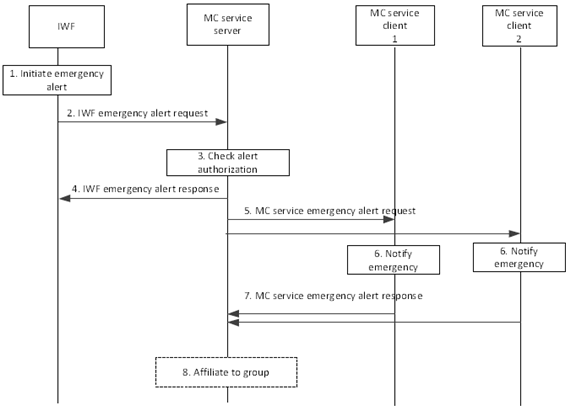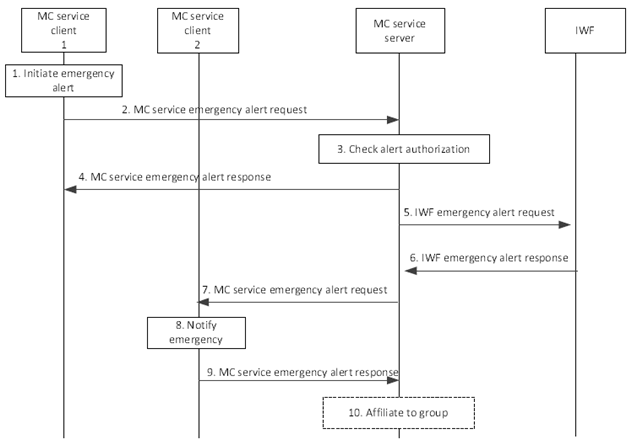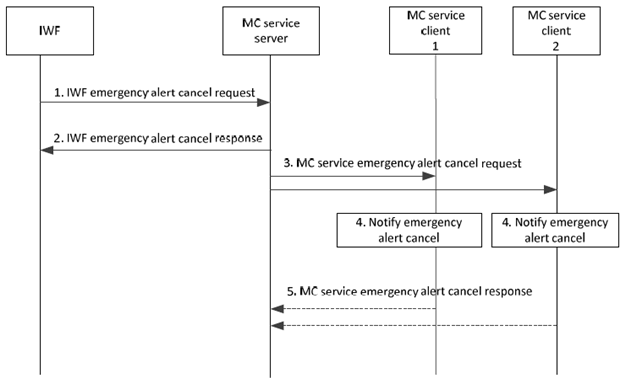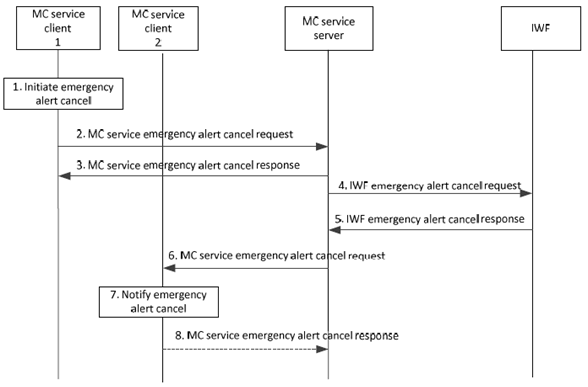Content for TS 23.283 Word version: 18.1.0
1…
10…
10.2…
10.2.2…
10.2.3…
10.3…
10.3.3…
10.3.3.7…
10.3.4…
10.3.4.4…
10.3.5…
10.3.5.8…
10.3.6…
10.3.7…
10.3.7.5…
10.3.8…
10.4…
10.4.4…
10.5…
10.5.7…
10.6…
10.6.2…
10.6.2.3…
10.6.3…
10.6.4…
10.7…
10.8…
10.11…
10.11.4…
10.12…
10.14…
10.15…
10.6.4 Emergency alerts
10.6.4.1 Emergency alert initiated by LMR user
10.6.4.2 Emergency alert initiated by MC service user
10.6.5 Emergency alert cancellation
10.6.5.1 Emergency alert cancellation of an LMR user
10.6.5.2 Emergency alert cancellation of an MC service user
...
...
10.6.4 Emergency alerts p. 138
10.6.4.1 Emergency alert initiated by LMR user p. 138
In this procedure, an LMR user is initiating an emergency alert via the IWF. Figure 10.6.4.1-1 shows the procedure for an emergency alert initiated by a user in the LMR system. This subclause is based upon subclause for MCPTT emergency alerts in TS 23.379, subclause 10.6.2.6.3.1.
Pre-conditions:
- The MC service group is previously defined on the group management server with MC service client 1 and MC service client 2 affiliated to that MC service group.
- The IWF is connected to and is authorized to interwork with the MC system.
- The MC service group information is available at the IWF, including information that the MC service group is an interworking group (defined in the LMR system or MC the system).
- The mapping relationship of group and user identities between the MC system and the LMR system has been configured at the IWF.
- The IWF may or may not have carried out an explicit affiliation procedure with the MC service group.
- An emergency alert is requested on the LMR system.

Step 1.
The LMR user initiates an emergency alert.
Step 2.
The IWF sends an IWF emergency alert request to the designated MC service server. If the location of the LMR user is not available to the IWF, the IWF emergency alert request shall contain an indication that location is not available.
Step 3.
MC service server checks whether the MC service user ID that represents the LMR user is authorized for initiation of MC service emergency alerts for the indicated MC service group. The MC service server determines the affiliation status of the group members.
Step 4.
The MC service server sends an IWF emergency alert response to the IWF to confirm the IWF emergency alert request.
Step 5.
The MC service server sends an MC service emergency alert request towards the MC service clients of each of those affiliated MC service group members. The MC service emergency alert request message shall contain the following information: Location, MC service ID and MC service group ID (i.e., MC service user's selected MC service group or dedicated MC service emergency group, as per MC service group configuration) and the MC service user's mission critical organization name.
Step 6.
MC service users are notified of the MC service emergency.
Step 7.
The receiving MC service clients send an MC service emergency alert response to the MC service server to acknowledge the MC service emergency alert request.
Step 8.
If the group is an interworking group defined in the MC system, the MC service server implicitly affiliates the individual MC service ID of the LMR user to the emergency group if not already affiliated. If the IWF is configured to affiliate on behalf of all of its group members in a single affiliation step, the MC service server affiliates the IWF ID instead of an individual MC service ID.
10.6.4.2 Emergency alert initiated by MC service user p. 139
In this procedure, an MC service user is initiating an emergency alert that is delivered to the LMR system via the IWF. Figure 10.6.4.2-1 shows the procedure for an emergency alert initiated by a user in the MC system. This subclause is based upon subclause for MCPTT emergency alerts in subclause 10.6.2.6.2.1 of TS 23.379.
Pre-conditions:
- The MC service group is previously defined on the group management server with MC service client 1 and MC service client 2 affiliated to that MC service group.
- The IWF is connected to and is authorized to interwork with the MC system.
- The MC service group information is available at the IWF, including information that the MC service group is an interworking group (defined in the LMR system or the MC system).
- The mapping relationship of group and user identities between the MC system and the LMR system has been configured at the IWF.

Figure 10.6.4.2-1: MC service emergency alert initiated by MC service user
(⇒ copy of original 3GPP image)
(⇒ copy of original 3GPP image)
Step 1.
The MC service user 1 initiates an emergency alert.
Step 2.
MC service client 1 sends an MC service emergency alert request to the MC service server.
Step 3.
The MC service server resolves the group ID, determines the affiliation status of the group members and checks whether the IWF should be informed. In this scenario, the group has affiliated members that are homed on the IWF, thus the IWF shall be involved. MC service server also checks whether the MC service user ID is authorized to initiate MC service emergency alerts for the indicated MC service group.
Step 4.
The MC service server sends an MC service emergency alert response to the MC service client 1 to confirm the MC service emergency alert request.
Step 5.
MC service server sends an IWF emergency alert request to the IWF. If the location of the MC service client 1 is not available, the IWF emergency alert request shall contain an indication that location is not available. If the IWF has affiliated to this group on behalf of the group's LMR users, only one IWF emergency alert request is sent to the IWF. If the IWF has sent individual affiliations for each of its LMR users, the MC service server sends an IWF emergency alert request via the IWF to each affiliated LMR group member.
Step 6.
The IWF sends an IWF service emergency alert response to the MC service server to confirm the IWF emergency alert request(s).
Step 7.
The MC service server sends an MC service emergency alert request towards the MC service clients of each of those affiliated MC service group members. The MC service emergency alert request message shall contain the following information: Location, MC service ID and MC service group ID (i.e., MC service user's selected MC service group or dedicated MC service emergency group, as per MC service group configuration) and the MC service user's mission critical organization name.
Step 8.
MC service users are notified of the MC service emergency.
Step 9.
The receiving MC service clients send an MC service emergency alert response to the MC service server to acknowledge the MC service emergency alert.
Step 10.
The MC service server implicitly affiliates the MC service client 1 to the emergency group if it is not already affiliated.
10.6.5 Emergency alert cancellation p. 141
10.6.5.1 Emergency alert cancellation of an LMR user p. 141
In this procedure, an LMR user is cancelling the emergency alert. Figure 10.6.5.1-1 shows the procedure for emergency alert cancellation of a user in the LMR system. This subclause is based upon subclause for MCPTT emergency alert cancel in TS 23.379, subclause 10.6.2.6.3.2.
Pre-conditions:
- The MC service group information is available at the IWF, including information that the MC service group is an interworking group (defined in the LMR system or the MC system).
- The LMR user had previously successfully initiated an emergency alert via the IWF.
- The MC service client 1 and MC service client 2 are affiliated to the MC service group.
- The MC service server may have carried out an explicit or implicit affiliation procedure of the LMR user to the MC service group.
- he mapping relationship of group and user identities between the MC system and the LMR system has been configured at the IWF.
- The LMR user initiates an emergency alert cancel.

Figure 10.6.5.1-1: MC service emergency alert cancellation of an LMR user
(⇒ copy of original 3GPP image)
(⇒ copy of original 3GPP image)
Step 1.
The IWF sends an IWF emergency alert cancel request to the MC service group to which the IWF had previously successfully sent the IWF emergency alert request on behalf of the LMR user.
Step 2.
The MC service server sends the IWF emergency alert cancel response to the IWF to confirm the IWF emergency alert cancellation.
Step 3.
The MC service server sends an MC service emergency alert cancel request to the MC service clients of the affiliated MC service group members.
Step 4.
MC service users are notified of the MC service emergency alert cancellation of the LMR user.
Step 5.
The receiving MC service clients send the MC service emergency alert cancel response to the MC service server to acknowledge the MC service emergency alert cancel request. For a multicast call scenario, these acknowledgements are not sent.
10.6.5.2 Emergency alert cancellation of an MC service user p. 142
In this procedure, an MC service user is cancelling the emergency alert. Figure 10.6.5.2-1 shows the procedure for emergency alert cancellation from a user in the MC system. This subclause is based upon subclause for MCPTT emergency alerts in subclause 10.6.2.6.2.2 of TS 23.379.
Pre-conditions:
- The MC service group information is available at the IWF, including information that the MC service group is an interworking group (defined in the LMR system or the MC system).
- The MC service client 1 had previously successfully initiated an MC service emergency alert request.
- The MC service client 1 is still in the emergency state.
- The MC service client 2 is affiliated to the MC service group.
- The MC service server may have carried out an explicit or implicit affiliation procedure of the LMR user with the MC service group.
- The mapping relationship of group and user identities between the MC system and the LMR system has been configured at the IWF.

Figure 10.6.5.2-1: MC service emergency alert cancellation of an MC service user
(⇒ copy of original 3GPP image)
(⇒ copy of original 3GPP image)
Step 1.
The user at the MC service client 1 initiates an emergency alert cancel.
Step 2.
MC service client 1 requests the MC service server to send an MC service emergency alert cancel to the MC service group to which MC service client 1 had previously sent the emergency alert request. The MC service server resolves the group ID, determines the affiliation status of the group members and checks whether the IWF should be informed. In this scenario, the group has affiliated members that are homed on the IWF, thus the IWF shall be involved.
Step 3.
The MC service server sends the MC service emergency alert cancel response to the MC service client 1 to confirm the MC service emergency alert cancel request. MC service client 1 resets its emergency state.
Step 4.
The MC service server sends an IWF emergency alert cancel request(s) to the IWF. If the IWF has affiliated to this group on behalf of the group's LMR users, only one IWF emergency alert cancel request message is sent to the IWF. If the MCPTT server has received individual affiliations from the group's LMR users, an individual IWF emergency alert cancel request message is sent to the IWF for each affiliated LMR user.
Step 5.
The IWF sends an IWF emergency alert cancel response(s) to the MC service server to acknowledge the IWF emergency alert cancel request(s).
Step 6.
The MC service server sends an MC service emergency alert cancel request towards the MC service clients of the affiliated MC service group members.
Step 7.
MC service users are notified of the MC service emergency alert cancellation of MC service client 1.
Step 8.
The receiving MC service clients send the MC service emergency alert cancel response to the MC service server to acknowledge the MC service emergency alert cancel request. For a multicast call scenario, these acknowledgements are not sent.